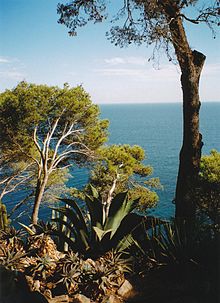Palafrugell
| Palafrugell parish | ||
|---|---|---|
| coat of arms | Map of Spain | |

|
|
|
| Basic data | ||
| Autonomous Community : | Catalonia | |
| Province : | Girona | |
| Comarca : | Baix Empordà | |
| Coordinates | 41 ° 55 ' N , 3 ° 10' E | |
| Height : | 64 msnm | |
| Area : | 26.89 km² | |
| Residents : | 22,974 (Jan 1, 2019) | |
| Population density : | 854.37 inhabitants / km² | |
| Municipality number ( INE ): | 17117 | |
| administration | ||
| Official language : | Castilian , Catalan | |
| Mayor : | Lluís Medir i Huerta | |
| Website : | ajpalafrugell.org | |
| Location of the municipality | ||

|
||
Palafrugell ( cat . [ Pəɫəfɾuˈʒeʎ ]) is a Catalan city in the province of Girona on the central Costa Brava and has 22,974 inhabitants ( INE as of January 1, 2019).
The city of Palafrugell is part of an administrative community (in Catalan municipi ), which also includes the small coastal towns of Calella de Palafrugell , Llafranc and Tamariu and five other districts.
The urban area covers an area of approx. 27 km² and is approx. 2.5 km from the coast.
history
In the 5th and 6th centuries, many coastal residents moved to Palafrugell because the coast was no longer safe. The city first appeared in writing in a document dated November 3, 988. Here it is still mentioned as Palau Frugell ; Palau means "the protected house" and Frugell is a Germanic proper name.
From the 12th to the 19th centuries, Palafrugell was under the rule of the Prior of Saint Anne of Barcelona. During the 16th century, watchtowers and new houses were built in the municipality of Palafrugell. The population growth was related to the increasing traditional economies such as agriculture and fishing, but the increasing demand for cork also played a major role. Another significant historical event was the so-called Palafrugell battle on July 20, 1638. In the 19th century, Palafrugell's economy consisted mainly of the production of corks. During the 1930s, the city was shaped by tourism. In the 1960s, the infrastructure was improved and population growth followed.
Attractions
The cork factory Manufacturas de Corcho Armstrong SA , built in 1904 in the style of Modernism , is now an industrial monument, as the cork production was relocated to another building. The Museu del Suro cork museum, which has existed since 1991, provides information about corks and how the economic development of Palafrugell is related to it. This includes a small shop where you can buy cork products.
The Fundació Josep Pla Museum , which is located in and next to the house where Josep Pla was born at Carrer Nou 51, reports on the life and works of the writer. Here you will also find Pla's library, which contains around 5000 documents, including manuscripts, pictures and newspapers.
The Cap Roig Botanical Garden (Jardí Botànic de Caixa Girona) in Calella de Palafrugell is also worth seeing . In 1927 the Russian exiled Colonel Nicolai Woevodsky and his wife Dorothy Webster, who came from the British aristocracy, bought land there, built a neo-Romanesque castle as a residence and laid out a Mediterranean landscape park on a beautiful hillside facing the sea , which formed the basis for today's botanical garden .
Personalities
The writer Josep Pla (1897–1981), who mainly dealt with the cultural tradition of the Costa Brava in his works, was born in Palafrugell.
The landscape painter Josep Costa Sobrepera was born in Palafrugell in 1937 and works here.
Town twinning
-
 Mirepoix (France) since November 1984
Mirepoix (France) since November 1984
Web links
Individual evidence
- ↑ Cifras oficiales de población resultantes de la revisión del Padrón municipal a 1 de enero . Population statistics from the Instituto Nacional de Estadística (population update).
- ↑ The Jardí Botànic de Caixa Girona


